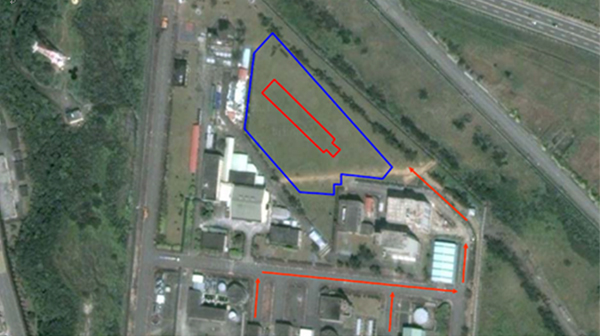The concrete cask technology adopted in the dry storage facilities of Chinshan and Kuosheng Nuclear Power Plants involves loading the spent nuclear fuel into a canister and filling it with inert gas before sealing it. The sealed canister is then placed into the concrete cask. By using metal and concrete as barriers, radiation can be stopped from the external environment,to reduce the potential impact on the environment and residents to the lowest possible amount. In addition, the natural convection of air can remove heat, without the need to use water at all for cooling.
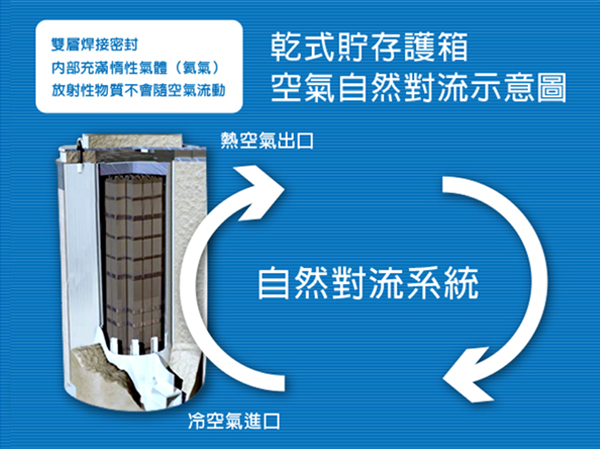
Design Basis and Safety Design
Safety design of spent nuclear fuel:
The fuel cladding of the spent nuclear fuel and the fuel pellets made of high-density ceramic uranium dioxide encapsulate the radioactive material produced by nuclear fission. This is the safety design inherent in spent nuclear fuel itself.
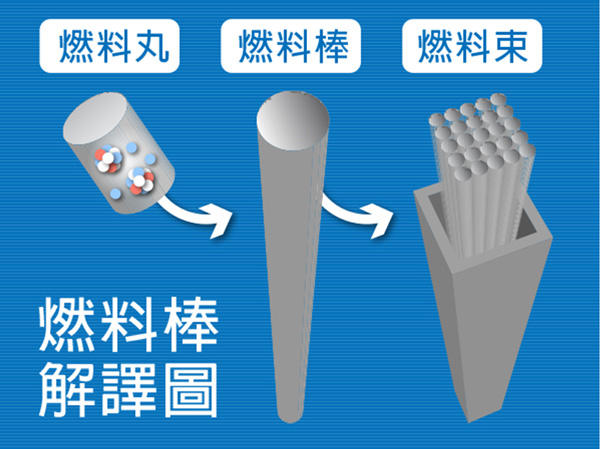
Canister
Spent fuels that have been cooled over a long time is placed into stainless steel canister, which thicknesses of 1.6 cm and 1.27 cm, respectively, and the canisters are filled with inert gas before sealing to prevent radioactive material from leaking. The natural convection in air will remove the trace amount of residual heat from the surface of the sealed canister.

Reinforced Concrete Structure
The sealed canister containing spent fuels is placed into the outer ring-shaped reinforced concrete container, which is lined with carbon steel on the inside, to further isolate the spent nuclear fuel from the external environment and stop radiation exposure, thereby ensuring the safety of the surrounding environment and the public.
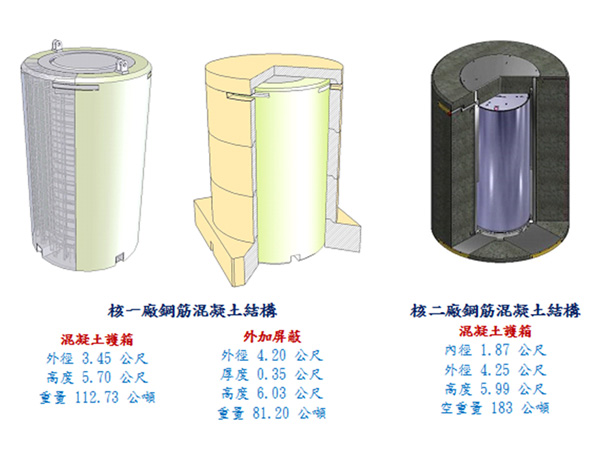
Chinshan Phase-1 Dry Storage Program
Capacity and site of facilities:
● 30 concrete casks are planned to be installed, with a storage capacity of 56 bundles of spent nuclear fuel per cask, and a total storage capacity of 1,680 bundles of spent nuclear fuel.
● The storage site is located in an open area (about 0.45 hectares) on the left bank downstream of Ganhua Creek in the southwest of the plant area of Chinshan Nuclear Power Plant, with an average elevation of about 24 m above sea level.
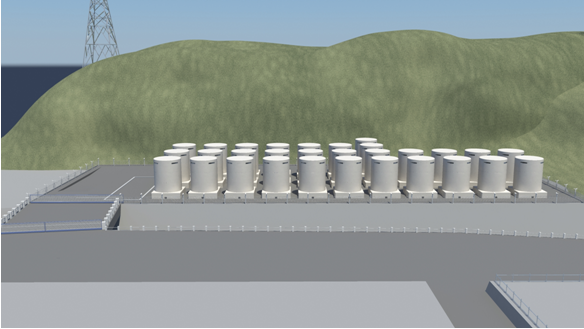
Design standards and conservation testing:
●Radiation protection:
The design of the dry storage facility for Chinshan Nuclear Power Plant is based on the concrete cask storage system approved by the United States Nuclear Regulatory Commission, with improved safety standards; to accommodate relevant environmental assessment commitments, the effective dose rate per person at site boundaries must not exceed 0.05 mSv per year, which is one-fifth of the 0.25 mSv per year stipulated by current regulations in Taiwan. (Note: According to information published by the Atomic Energy Council, Taiwan, the natural background radiation dose acceptable per person per year in Taiwan is about 1.6 mSv.)
● Tsunami protection:

Taipower completed the “Overall Tsunami Inspection and Evaluation for Nuclear Power Plants” report in April 2012. It showed that the tsunami run-up height ranged from 4.11 m to 5.47 m above sea level, which was lower than the main plant base elevation of 11.2 m above sea level, thus the various facilities of the main plant area will not be affected. The elevation of the dry storage site is approximately 22 m (the elevation of the completed surface of the storage facility platform is approximately 24 m).
● Status of plan implementation:
A review team comprising 30 local experts and scholars was assembled by the Atomic Energy Council, Taiwan, for the safety analysis report for this project, which was divided into the following 10 groups: overall safety, site safety, nuclear criticality safety, shielding and radiation protection, structure safety, heat transfer safety, sealing safety, accident safety, fire safety, and quality assurance. After five rounds of review, safety concerns were cleared, and it was confirmed that the construction of the facility can meet safety requirements, and is sufficient to ensure the safety of the public and the facility. The project was approved by the Atomic Energy Council, Taiwan, on January 21st, 2008.
Civil engineering works: These have been completed in February 2013.
Storage, hoisting, and other relevant auxiliary equipment: These have completed construction
The first stage of pre-operation (Dry-Run) started in June 2012 and completed on November 14th, 2012. The “Dry-Run Report of Pre-Operation” was sent to the Atomic Energy Council, Taiwan, for review on March 8th, 2013. The reportwas approved by the Atomic Energy Council on September 24th, 2013, and the project was given approval to enter the second stage of pre-operation (Hot Test).
As the New Taipei City Government has not yet issued a certificate of completion for “the soil and water conservation facilities,” the schedule for the second stage of pre-operation (Hot Test) of the storage facility cannot be carried out yet. In order to carry out hot test as soon as possible, Taipower is actively processing the relevant analysis, evaluation, response, and clarification procedures in accordance with the review feedback related to water conservation plans from the New Taipei City Professional Civil Engineers Association.
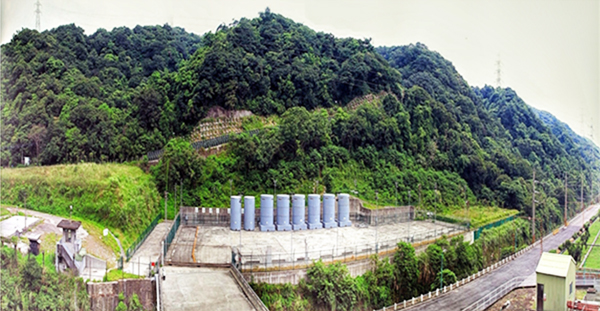
Kuosheng Phase-1 Dry Storage Program
Capacity and site of facilities:
● 27 concrete casks are planned to be installed, with a storage capacity of 87 bundles of spent nuclear fuel per cask, and a total storage capacity of 2,349 bundles of spent nuclear fuel.
● The storage site is located in the open area (about 0.84 hectares) north of the plant area of Kuosheng Nuclear Power Plant.

Design standards and conservation testing:
● Radiation protection:
The design of dry storage facilities at Kuosheng Nuclear Power Plant is based on the concrete cask storage system approved by the United States Nuclear Regulatory Commission, with improved safety standards, so as to accommodate the relevant environmental assessment commitments, in which the effective dose rate per person at site boundaries must not exceed 0.05 mSv per year, which is one-fifth of the 0.25 mSv per year stipulated by current regulations in Taiwan. (Note: According to information published by the Atomic Energy Council, Taiwan, the natural background radiation dose acceptable per person per year in Taiwan is about 1.6 mSv)
●Tsunami protection:
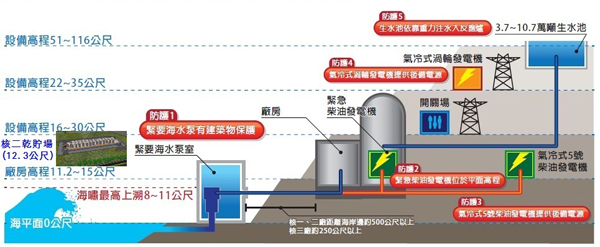
Taipower completed the “Overall Tsunami Inspection and Evaluation for Nuclear Power Plants” report in April 2012. The results showed that the tsunami run-up height ranged from 4.37 m to 4.66 m above sea level, which was lower than the main plant base elevation of 12 m above sea level, thus the various facilities of the main plant area will not be affected. At present, the elevation of the Second Nuclear Power Plant is more than 12 m above sea level, and the elevation of the dry storage facility platform is about 12.3 m, both of which will not be affected by a tsunami.
For the purpose of improving the tsunami protection capacity of the dry storage site of the Second Nuclear Power Plant, Taipower took extreme situations into consideration, and increased the recommended elevation from the tsunami evaluation for the dry storage site of the Second Nuclear Power Plant to 16.28 m, so as to prepare for a scenario in which a tsunami exceeding design standards occurs. The three-dimensional analysis and evaluation report (“Evaluation Report on Tsunami Impact on Dry Storage Facility for Spent Nuclear Fuel of the Second Nuclear Power Plant”) was approved by the Fuel Cycle and Materials Administration for use as future reference. The evaluation results showed that the concrete casks at various positions will not slide or be overturned (F.S > 1.0) in the event of a serious tsunami, and that the structure is stable.
● Status of plan implementation:The plan has obtained the relevant licenses and permits required for construction, including the following: “Statement of Environmental Impact,” “Environmental Difference Analysis Report,” “Environmental Status Difference Analysis and Countermeasure Review Report,” “Table of Comparison of First Changes,” construction license, and construction permit for soil and water conservation plans.
The procurement of storage facilities for this project was finalized in November 2010. It was approved by the Atomic Energy Council, Taiwan, on February 9th, 2015, and the construction license was issued by the Atomic Energy Council on August 7th, 2015. The Council of Agriculture approved the “Water and Soil Conservation Plan” on December 14th, 2015, and issued the “Water and Soil Conservation Construction Permit” for the project on February 2nd, 2016.
